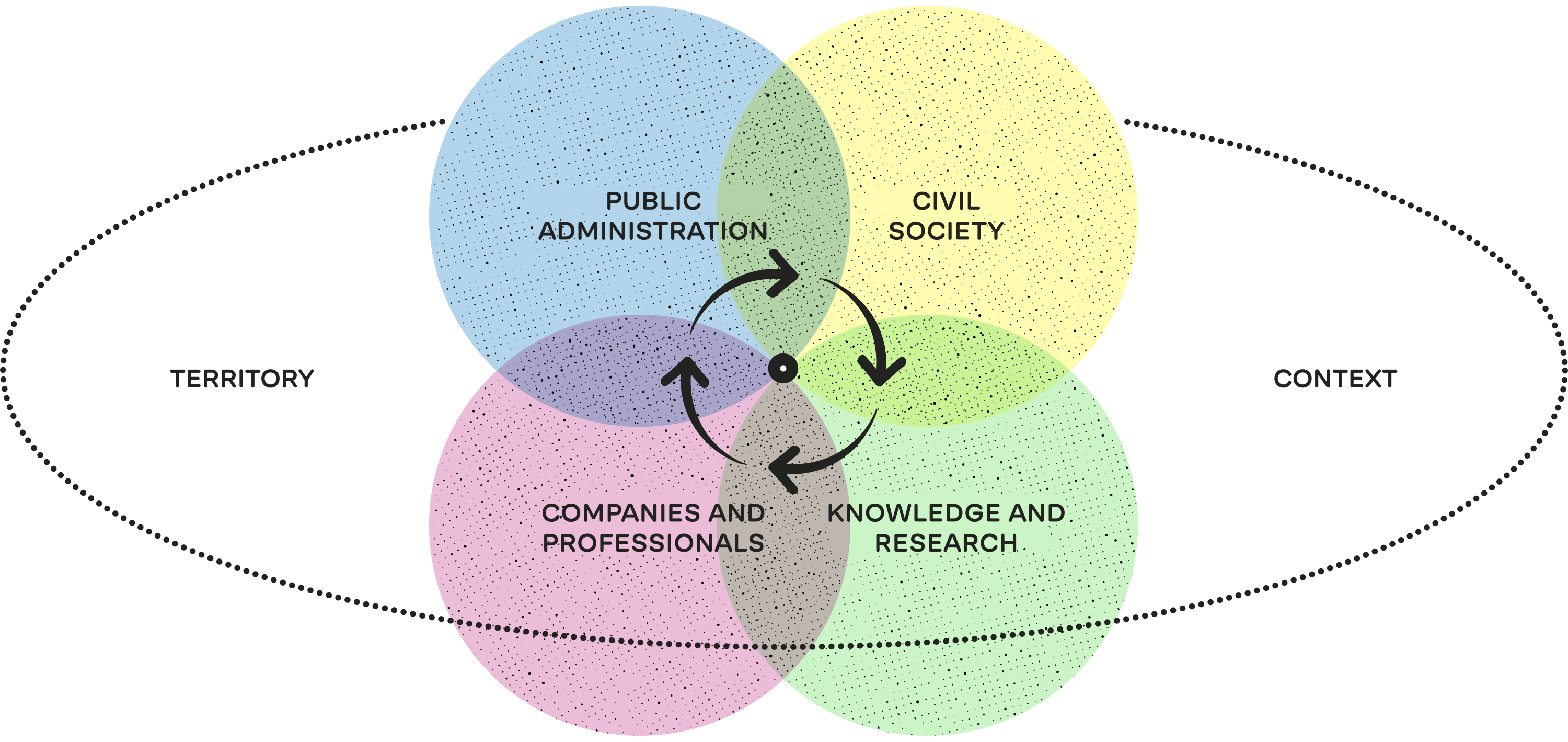What
Network Coordination
Colaboratorio IC is opening an inclusive, self-managed space for meeting, connection and action whose purpose is to coordinate the Civic Innovation (CI) ecosystem.
AND WE WANT YOU TO BE A PART OF IT!
- Colaboratorio: An open and distributed work group which collaborates and shares resources in order to develop projects and processes with common goals.
- Civic Innovation (CI): The involvement of the very people affected by the challenges and needs of their communities in collaboratively reaching meaningful, creative solutions which are adapted to their real lives.
- Coordination: Acknowledge, understand, relate and organise all parties involved in order to build things together (networks, projects, shared resources).
- Ecosystem: A shared environment which consists of a wide, diverse range of actors.
Colaboratorio IC is rooted in the sharing of processes, learning and resources with agents and networks primarily located in Ibero-America and Europe.
TOGETHER WE ARE STRONGER!
Why
Recognition and Raising Awareness
Civic Innovation has, for a long time, been developing, growing and demonstrating its worth when it comes to providing solutions. In its myriad different forms, it has shown its capacity and effectiveness in overcoming obstacles and challenges in all areas of life where, due to the scale, complexity or urgency of the challenges faced, solutions offered by current institutional, technoscientific and market systems are falling short.
It is clear that Civic Innovation will be a decisive element in confronting the transformations and transitions which lie ahead of us. This is why we need it to be given more visibility and recognition, as well as the required support to fulfil its potential.
Organising and energising the innovation ecosystem is of vital importance, with a clear focus on Civic Innovation in both practice and results. To respond to today’s challenges we need everyday citizens to be involved in this rich, diverse and active ecosystem.
How
Reflection and Proposal
Colaboratorio IC promotes and disseminates Civic Innovation through processes of collective intelligence based on the following questions:
- How can we support the development and sustainability of Civic Innovation ecosystems, the collaboration and hybridisation between different actors, and the scale and transferability of their contributions? How can we join up different regional and skills-based scales to construct a federated system?
- How do we inspire more widespread use of Civic Innovation and make it an ongoing part of everyday life, as opposed to something reserved only for moments of crisis? How do we connect it to democratic participation, and to people’s challenges and life plans?
- How can we achieve the necessary conditions for Civic Innovation to become a cornerstone of responding to the challenges we face as a society?
- How can we scale up the principles of Civic Innovation and laboratories to create a wider, diversified network of local facilities such as schools, libraries, health centres, cultural and community centres, sports centres, telecentres and employment offices?
- How can we defend Civic Innovation’s position as a distinct field in relation to nationally recognised Science, Technology and Innovation Systems? How can Civic Innovation be merged with other forms of innovation such as Social, Open, Public, Cultural or Digital?
The answers to all these questions can be found using the logic of Civic Innovation itself: networked collaboration, involvement of those directly affected, and interim solutions through prototyping.
Aims
Support, Steward and Facilitate
The main aim of Colaboratorio IC is to support and steward the coordination of the Civic Innovation ecosystem, with a focus on:
- Identifying its agents and making them visible, with respect for their diversity and their interdependent, shared responsibilities.
- Connecting and mobilising agents, strengthening existing good work and encouraging collaboration via meaningful, sustainable and feasible relationships.
- Building agreements and projects around common goals.
- Co-producing and sharing frameworks, infrastructure, tools, methodologies and resources which enable and encourage collaboration.
- Scaling up and transferring the strengths and lessons learned from Civic Innovation projects into new sectors and territories.
- Raising awareness of the cohesive and transformative potential of Civic Innovation by involving institutions, prominent social figures, the media and so on.
Civic Innovation
An open-ended definition
Civic Innovation is rooted in the active involvement of civil society, the very people affected by and invested in the challenges they face. It is co-produced thanks to the involvement of different agents, merging expert, technical knowledge with amateur skills which stem from real, lived experience. It seeks collective solutions to improve lives and surroundings which can take any form (services, products, processes, policies etc). Those solutions which work well can be developed on a larger scale and transferred to meet the needs of other places, people and organisations.
Civic Innovation is seen by Colaboratorio IC as a flexible, transversal term which is diametrically opposed to bias or preconception. It can be appropriated and adapted for use in fields as wide-ranging as culture, science, education, the environment, healthcare, community support, economics, sport, or technology, and CI can only grow with the addition of each new project. As the saying goes, the more the merrier!
Social, open, public, cultural y digital
Civic Innovation puts forward the involvement of members of civil society – their knowledge, experience, perspective and priorities – as the key to finding solutions to complex problems. It is enriched and strengthened when combined transversally with other forms of innovation, much like how these other forms can benefit from embracing civic participation:
- Social Innovation: searching for meaningful, beneficial solutions and improvements to challenges in all areas of life: healthcare, the environment, education, models of production, food supply, care work, inequality etc.
- Open Innovation: co-producing new, collaborative and distributed knowledge and experiences via the logical frameworks of collective intelligence, Open Source code and hacker ethics to encourage scaleable, replicable models of cooperation and transparency.
- Public Innovation: working to create value for public systems, not only to invigorate and strengthen them (for example new services, procedures and ways of participating), but also to develop transformative projects which are rooted in different skill sets, with public-social collaboration at their core.
- Cultural Innovation: harnessing the power of imagination, art and creativity to tell new stories and forge new meaning, relationships and customs; interrogating and expanding the limits of our own conventions through experimentation; ensuring that robust cultural rights are extended to all.
- Digital Innovation: ethically developing technological tools, environments and social norms based on emergent technology (collaborative platforms, the internet of things, Big Data, digital manufacturing, blockchain, artificial intelligence etc), while fostering technological sovereignty and working to overcome the digital divide.
Shared Framework
The logic of the Quintuple Helix
Civic Innovation forms part of the Quintuple Helix model of innovation, a development and improvement of the conventional Triple Helix model (government / academia / private sector). This model was first expanded with the Quadruple Helix, incorporating the skills, expertise and influence possessed by members of civil society (both organised and non-organised citizens), and the fifth is made up of the conditions related to each specific region and environment, leading the context itself to create and mould innovations.
The Quintuple Helix’s success in fostering innovation is rooted in the combined strength and diversity of agents, and in not assigning strict roles to each helix, choosing instead to “go with the flow” and allow relationships and interactions to cross-pollinate between them. For this to happen, citizens must fulfil their potential as agents and producers of innovation, capable of disruptively challenging innovative processes, as well as seeking, and maybe attaining, entirely new kinds of results.

The SDG Doughnut
At Colaboratorio IC we are disciples of Doughnut Economics, which places Civic Innovation within a broad framework whose clear limits ensure a safe and fair future for all. The centre of the doughnut consists of the Social Foundation which covers people’s basic needs; the exterior sets an Ecological Ceiling to limit our actions to “Zero Impact” on the environment and the planet.

The UN Agenda 2030 Sustainable Development Goals (SDGs) enhance our roadmap in this respect, and at Colaboratorio IC we divide them into two interrelated groups:
- Shared SDGs, situated at the inner and outer limits of the doughnut which form part of all our actions. These relate to either the Social Foundation (SDG 1 No Poverty, SDG 2 Zero Hunger and SDG 3 Good Health and Wellbeing), or the Ecological Ceiling (SDG 13 Climate Action, SDG 14 Life Below Water and SDG 15 Life On Land).
- Operative SDGs (all SDGs from SDG 4 to SDG 12 as well as SDG 16), which occupy the centre of the circle and vary depending on the interests, aims and objectives of any given project.
Additionally, SDG 17 transversally establishes alliances, to which we can also add SDG Culture for Change, which adopts UNESCO’s anthropological view of culture.


